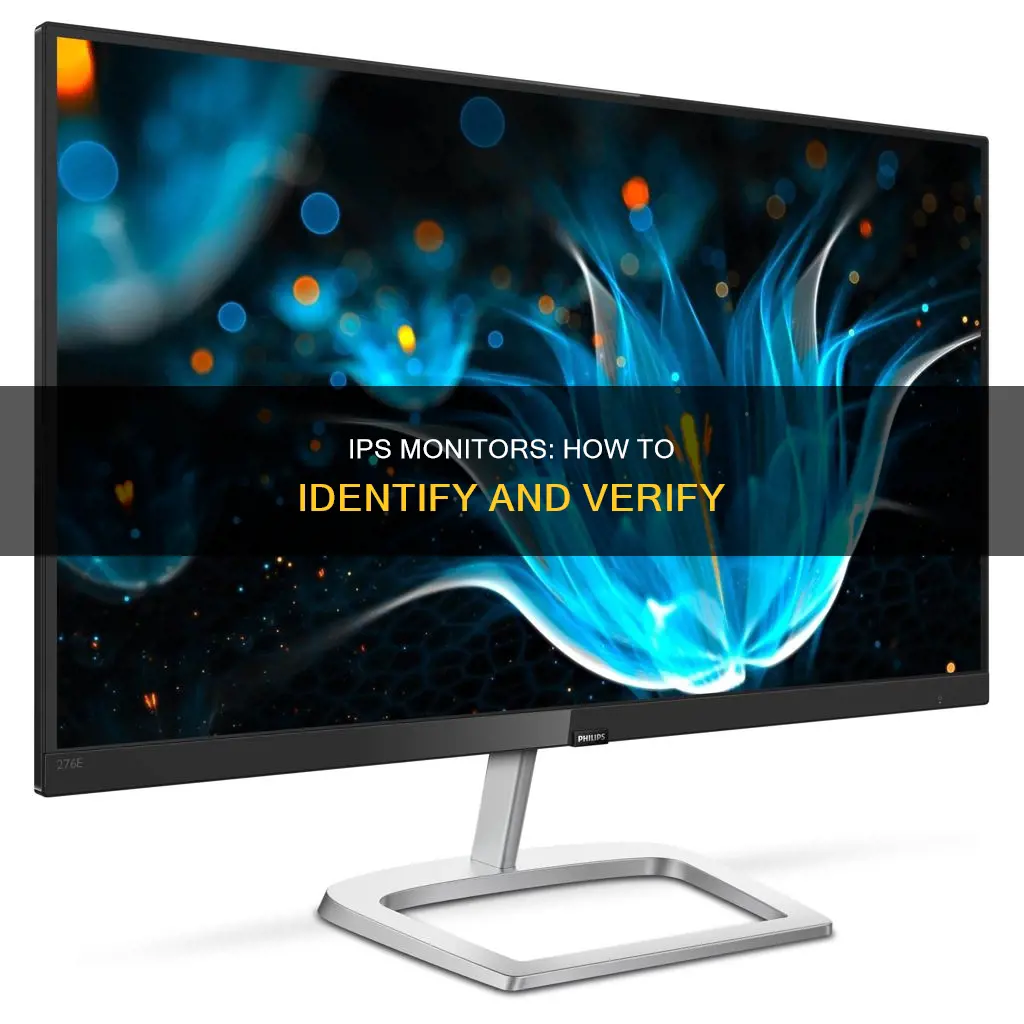
IPS monitors, or In-Plane Switching monitors, are one of the four main panel types for monitors, the others being TN, VA, and OLED. IPS monitors are defined by the shifting patterns of their liquid crystals, which are aligned in parallel to produce rich colours. This technology was designed to overcome the limitations of TN panels, which have a narrower viewing angle and more colour shifting when viewed at an angle. To identify an IPS monitor, you can look at the monitor screen from extreme angles – if the image and colour quality stay relatively stable, it is likely an IPS monitor. IPS monitors usually have a 178-degree viewing angle. Another way to check is to open the display manager by right-clicking on your desktop – the type of monitor should be listed under Display.
| Characteristics | Values |
|---|---|
| Viewing angles | IPS monitors have wider viewing angles than TN monitors. IPS offers ultra-wide 178-degree vertical and horizontal viewing angles, while TN panels are limited to approximately 170 degrees horizontal and 160 degrees vertical. |
| Colour accuracy | IPS monitors offer better colour accuracy and consistency than TN and VA monitors. They can support professional colour space technologies, such as Adobe RGB, and deliver outstanding colour when viewed from different angles. |
| Response time | IPS monitors have improved response times that can now satisfy gamers. However, TN monitors still offer the fastest response times and refresh rates on the market. |
| Use cases | IPS monitors are ideal for colour-critical professional applications, technology enthusiasts, higher-level business/home use, and gamers who value image quality over response time. TN monitors, on the other hand, are preferred by competitive gamers and users seeking rapid graphics display due to their faster response times. |
| Contrast | IPS monitors used to have a weakness in response time and contrast, but advancements have been made. TN monitors tend to offer higher contrast ratios, but IPS monitors have improved in this area as well. |
What You'll Learn

IPS monitors have a wider viewing angle than TN panels
IPS panels offer wider viewing angles than TN panels. This means that the colours and contrast remain consistent even when you’re viewing the screen from a side angle. TN panels, on the other hand, have narrow viewing angles, which can cause colours and contrast to shift dramatically when not viewed head-on. This can be a major drawback for people who often share their screen with others or for those who like to watch movies or play games from different positions.
IPS panels are defined by the shifting patterns of their liquid crystals. The liquid crystal’s ability to shift horizontally creates better viewing angles. IPS panels are known for their superior colour accuracy and wide viewing angles. They offer a more consistent and accurate colour display, regardless of the angle you’re viewing the screen from. This makes them an excellent choice for professionals who require accurate colour representation, such as graphic designers and photographers.
TN panels are the oldest LCD panel type and are the most affordable. They are a popular choice for competitive gamers as they can achieve rapid response times and the fastest refresh rates on the market. However, they fall short when it comes to colour accuracy and viewing angles.
IPS panels are generally known for their superior colour accuracy and wider viewing angles, but they can be more susceptible to image retention or burn-in. TN panels are praised for their fast response times and lower cost but may not offer the same level of colour accuracy or viewing angles as IPS panels.
Power Supply Hookup: Monitor Wires and Their Proper Places
You may want to see also

TN panels are the oldest LCD panel type
TN panels, or twisted nematic field effect panels, are the oldest type of LCD panel still in use. The technology has been iterated upon since the original digital watch designs, with the name coming from the fact that the molecules of liquid crystal are twisted by 90 degrees between two glass plates. Light shines through the liquid crystals and polarisation filters, activating the pixel on the screen.
TN panels are generally reserved for budget monitors these days, as they are some of the cheapest on the market. They have poorer colour accuracy, lower brightness, and slower refresh rates than other types of panels. They also have poor viewing angles; move to either side of a TN screen, and the colour will distort.
Despite these drawbacks, TN panels have their benefits. They have fast response times, and are versatile with no real-world limits on size, shape, resolution, and refresh rate. They are also readily available and suitable for those who are budget-conscious.
Monitoring Memory Usage in Embedded Linux: Practical Tips
You may want to see also

IPS monitors are defined by their shifting liquid crystal patterns
IPS monitors, or "In-Plane Switching" monitors, are defined by their shifting liquid crystal patterns. These monitors were designed to overcome the limitations of TN panels, leveraging the ability of liquid crystals to shift horizontally to create better viewing angles. The shifting patterns of liquid crystals in IPS panels produce rich colours and enhance colour accuracy and consistency.
IPS panels provide super-wide viewing angles, typically offering 178-degree vertical and horizontal viewing angles. This means that IPS monitors can deliver outstanding colour performance when viewed from different angles. This is a significant advantage over TN panels, which experience more colour shifting when viewed at an angle.
To identify if a monitor is an IPS panel, you can perform a simple test by observing the screen from extreme angles, both left to right and top to bottom. If the image and colour quality remain relatively stable, then it is likely an IPS panel.
Another method to determine the panel type is to use a display manager on your computer. On Windows, you can open the display manager by right-clicking on your desktop and checking the information under the "Display" section.
IPS monitors are widely used by graphic designers, CAD engineers, pro photographers, and video editors due to their exceptional colour accuracy and wide viewing angles. They are also becoming increasingly popular for gaming, as advancements in technology have improved IPS panel speed, contrast, and resolution.
iPhone X Display Size and Dimensions Explained
You may want to see also

TN panels are preferred by competitive gamers
TN panels, or Twisted Nematic panels, have been the go-to option for competitive gamers due to their lightning-fast response times and high refresh rates. In gaming, response time is critical as it determines how quickly a pixel can change colour, affecting the overall performance in fast-paced games where motion blur and ghosting can be detrimental. TN panels typically offer response times of 1ms to 2ms, with some high-end models reaching 0.5ms. This ensures that fast-moving objects appear sharp and clear, providing a smooth and responsive gaming experience.
TN panels are also known for their high refresh rates, which measure how often a monitor updates the image on the screen. Higher refresh rates result in less screen tearing and stuttering, creating a more immersive gaming experience. The latest TN monitors can reach refresh rates of up to 360Hz, offering a distinct advantage in competitive gaming where every millisecond counts.
In addition to their impressive performance, TN panels are highly affordable. Gamers can easily find high-performance TN monitors at reasonable prices, making them an accessible option for those seeking top-tier performance without breaking the bank. This affordability factor is particularly appealing to competitive gamers who prioritise speed and responsiveness over other factors.
While TN panels excel in speed, they may fall short in terms of colour accuracy and viewing angles when compared to IPS panels. TN panels often struggle to produce deep blacks and vibrant colours, which can impact the overall immersion of the gaming experience. Additionally, their narrow viewing angles can result in a noticeable decrease in image quality when viewed from the side, making them less ideal for gamers who play with friends or family members.
Despite these drawbacks, TN panels remain the preferred choice for competitive gamers due to their exceptional response times and refresh rates. For gamers who are willing to compromise on colour accuracy and viewing angles for the sake of faster response times, TN panels are the way to go.
Installing a Reversing Camera: LCD Mirror Monitor Guide
You may want to see also

IPS monitors are more affordable than ever
IPS monitors, or “In-Plane Switching” monitors, offer rich colours and wide viewing angles. They are known for their colour accuracy and consistency, making them ideal for graphic designers, CAD engineers, pro photographers, and video editors.
IPS monitors have improved over time, with faster response times, better contrast, and higher resolutions. They are now more affordable than ever, making them a great option for those seeking outstanding image quality.
IPS monitors have a few drawbacks, such as a below-average static contrast ratio, potential white glow when viewing dark content off-angle, and more motion blur than TN monitors. However, these issues are typically only noticeable on lower-end or off-brand IPS monitors.
IPS monitors are one of the four main panel types, including TN, VA, and OLED. When choosing a monitor, it's important to consider your intended usage and personal preferences. IPS monitors are known for their colour accuracy, making them ideal for photo editing and colour-critical professional applications.
IPS monitors have wide viewing angles of up to 178 degrees, ensuring consistent colour performance when viewed from different angles. This is a significant advantage over TN monitors, which experience more colour shifting when viewed at an angle.
LCD vs LED Monitors: Key Differences Explained
You may want to see also
Frequently asked questions
IPS monitors offer wider viewing angles, better colour accuracy and consistency, and faster response times than TN and VA panels. They are ideal for colour-critical professional applications such as photo editing and graphic design.
IPS monitors have a viewing angle of 178 degrees, whereas TN panels are limited to approximately 170 degrees horizontal and 160 degrees vertical. If the image and colour quality stay stable when viewed from extreme angles, it is likely an IPS monitor.
IPS monitors have a below-average static contrast ratio and may exhibit a white glow from off-angles when viewing dark content. They also have slower response times than TN panels, which can result in more visible motion blur.
For Windows users, right-clicking on your desktop and opening the display manager will bring up the display specifications. Alternatively, you can download an app such as HWinfo64, which will provide the model number of your monitor.
In addition to IPS, there are three other main types of monitor panels: TN (Twisted Nematic), VA (Vertical Alignment), and OLED (Organic Light-Emitting Diode). Each type has its own advantages and disadvantages, catering to different user needs.







